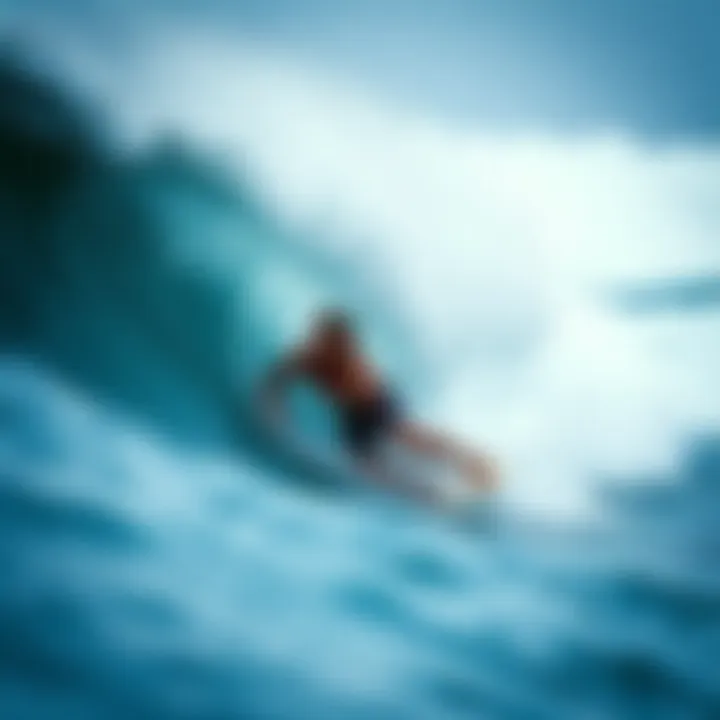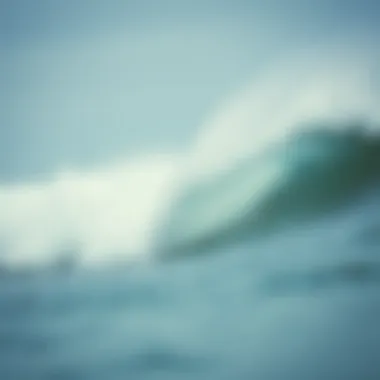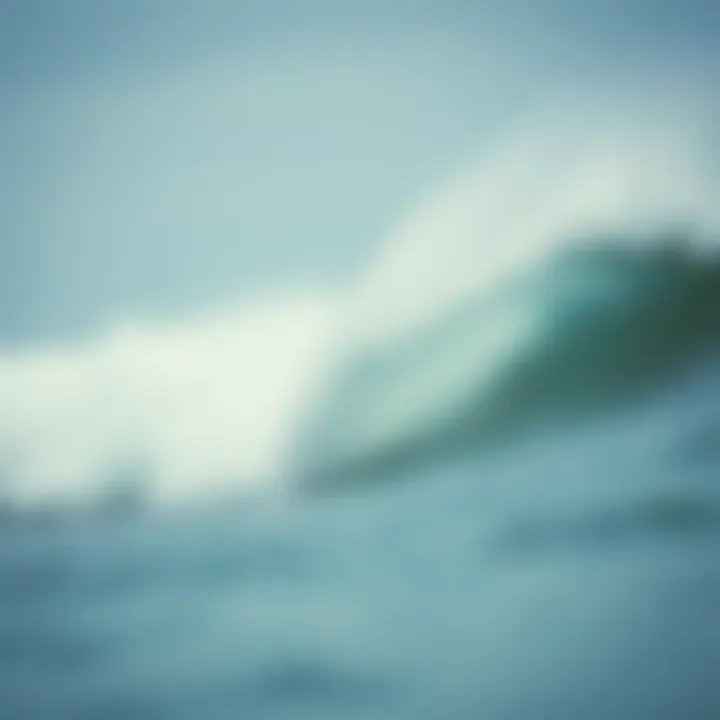Understanding Wind Gusts and Their Impacts on Surfing


Intro
Understanding wind gusts can be quite an adventure for surfers, especially when it comes to their impact on performance and enjoyment out on the water. Wind gusts are not just fleeting breezes; they can greatly shape the surfing experience, influencing wave conditions and overall safety in ways that every surfer needs to appreciate. Whether you’re waiting for the perfect set of waves or taking that exhilarating drop, knowing how wind gusts work at your local break can enhance your time on the board.
Surfing isn’t just about the waves, it’s also about a keen awareness of the environmental elements at play. If you can grasp how wind conditions can fluctuate, you set yourself up for both safe and successful sessions. In the sections that follow, we’ll break down what makes gusts tick, how to read the wind, and what gear can make all the difference.
Gear and Equipment
Your choice of gear is crucial, not just for performance, but also for handling the unpredictable nature of wind gusts. Let’s dive into the latest technologies and accessories that can elevate your surfing experience.
Latest Surfboard Technologies
Modern surfboards have come a long way, incorporating advanced materials and geometry to respond better to changing wind conditions. For instance, boards crafted with epoxy and various composite materials offer stiffness and responsiveness that can make a noticeable difference in gusty conditions. These boards are often lighter and can catch waves more easily, which is a boon during those wind-swept sessions.
Additionally, look for surfboards designed with hydrodynamic contours, which minimize drag and optimize speed. Designs like fish and hybrid models have gained popularity as they allow for quicker turns and better maneuvering, especially when the wind kicks up.
Essential Accessories for Every Surfer
Having the right accessories can enhance both your comfort and safety while surfing. Here’s a handy list of essentials:
- Wetsuits: Choose a suit suitable for your local climate. A thicker wetsuit can be beneficial in windy, cooler waters.
- Leashes: A reliable leash ensures you won’t lose your board during a gusty wipeout.
- Surf wax: The right grip can mean all the difference. Make sure you have your favorite wax to support balance—necessary for those windier days.
- Impact vests: It may sound a bit excessive, but it’s worth considering a vest for extra safety in turbulent conditions.
These items ensure you are not just riding the waves, but doing so in a way that maximizes enjoyment and minimizes risk. Remember, it’s not just about having the latest gadgets but knowing how to use them effectively in conjunction with the wind conditions.
Surf Techniques and Skills
Understanding the wind doesn't stop at gear; it also involves technique. Knowing how to read and respond to wind gusts can elevate your surfing game significantly.
Beginner Surfing Techniques
For those just getting their feet wet, mastering the basics means being conscious of the wind’s influence on your balance. Learning to paddle effectively when gusts pick up can save energy and keep you positioned on the wave. A tip is to keep your center of gravity low and remain agile, ready to shift weight as necessary. Practicing in calm conditions is recommended before tackling windier days.
Advanced Maneuvers for Experienced Surfers
More seasoned surfers can use wind gusts to their advantage, crafting tricky maneuvers that incorporate wave dynamics. For example, using gusts to gain speed when going for a big aerial trick can make a significant difference. Recognize where the strongest winds meet the swell, as this can provide that extra lift you need. Understanding your local spot’s unique combination of wind and wave patterns can transform your surfing, pushing you to new heights.
"A solid comprehension of wind nuances can be as essential as mastering your turns. For surfers, wind is a dance partner that can make any ride exhilarating or challenging."
As we delve deeper into this exploration of gusts and how they sculpt our surf experience, remember it’s as much about the knowledge as it is about skill. Taking the time to understand these elements can lead to safer, more rewarding surfing adventures.
For more insights and updated techniques, consider checking out resources like Wikipedia, Britannica, or dedicated forums on Reddit which are treasure troves of information shared by fellow surfers.
The Nature of Wind Gusts
Wind gusts are an integral aspect when one considers the dynamics of any given location, especially for outdoor enthusiasts like surfers. Understanding this phenomenon not only amplifies the appreciation for nature but can also be a game changer for those looking to improve their activities on the water. Being aware of how wind behaves can influence performance, safety, and enjoyment while engaging in surfing and other outdoor experiences.
Definition and Characteristics
Wind gusts can be described as short bursts of strong wind that can intensify suddenly and often swirl unpredictably. Unlike steady winds—which typically maintain a consistent speed—gusts are fleeting, making them challenging to forecast. Generally, a gust is categorized if it exceeds the average wind speed by at least 10 knots over a 10-minute period.
Some characteristics that define wind gusts include:
- Variability: Gusts can vary drastically in both intensity and duration, leading to varying impacts depending on the location.
- Direction Changes: Wind gusts can change direction quickly, which can be particularly hazardous for surfboarders navigating the waves.
- Intermittency: Unlike sustained wind, gusts come and go, and can affect timing for surfers looking for that perfect wave.
Familiarizing oneself with these aspects not only helps predict conditions more accurately but also prepares surfers to respond appropriately to changing circumstances in real-time.
How Wind Gusts Form
Wind gusts typically form due to a combination of physical factors, particularly topographical elements such as hills, buildings, and trees. These natural and man-made structures can disrupt the flow of air, causing localized areas of increased wind strength. Here are a few key factors that contribute to the formation of wind gusts:
- Thermal Differences: Variations in temperature at ground level can create pockets of warm air that rise quickly, causing surrounding cooler, denser air to rush in and generate gusts.
- Obstacles: The presence of obstacles can result in turbulence and unpredictable wind patterns. For example, gusts may be amplified when blowing down a hill and then suddenly hitting the surf.
- Weather Fronts: When a weather front moves in, changes in pressure and temperature can create strong gusts as storms approach.


Understanding how these gusts form is crucial; it enables surfers and outdoor adventurers to consider when and where wind conditions may be most favorable or, conversely, when it could become hazardous.
"The wind is our constant companion, sometimes to be feared, sometimes to be embraced. Knowing why it behaves as it does can make all the difference."
Being well-versed in the nature of wind gusts provides an invaluable knowledge base. For surfers, this can translate into better surf sessions and heightened awareness of safety concerns. Gathering insights about how gusts function sets the stage for a more informed and exhilarating adventure on the water.
Measuring Wind Gusts
Understanding how to measure wind gusts is crucial for everyone, especially surfers who want to harness the power of the wind for ideal conditions. Wind gusts can affect everything from the style of surfing you adopt to the safety of your activities, making it significant to have a handle on measurement practices. Accurately gauging these gusts allows surfers to better plan outings, avoid hazardous conditions, and enhance their performances on the waves.
Instrumentation Used
When it comes to measuring wind gusts, various tools are at your disposal. Key instruments include:
- Anemometers: These come in multiple forms, but most notably, the cup anemometer is popular due to its reliability and ease of use. As wind flows into the cups, they spin, and the rate of rotation signals the wind's speed. Advanced models can measure gusts and average wind speeds simultaneously.
- Portable Weather Stations: For those serious about tracking variations in real-time, portable weather stations offer convenience. Often equipped with an anemometer, they can monitor humidity, pressure, and temperature alongside wind data. This multifaceted approach provides a comprehensive overview of weather patterns at a surf spot.
- Smartphone Apps: Numerous applications cater to wind conditions, some leveraging data from nearby meteorological stations. These apps are handy for quick checks before hitting the waves, offering everything from wind speed to direction.
Each of these tools has its advantages, so selecting one largely depends on individual preferences and specific needs.
Data Collection Methods
Data collection methods for measuring wind gusts can vary widely based on location, technology, and the specific conditions one aims to understand. For surfers, some common methods include:
- Static Monitoring: Many surfers use fixed weather stations positioned near popular surf locations. These capture continuous data on gust patterns, enabling analysis over time. Riders can study how these patterns shift with the changing seasons or during events.
- Mobile Measurement: For a more tailored approach, surfers might carry portable anemometers. This method offers flexibility, allowing individuals to measure gusts directly at their usual surf spots, knowing precisely the conditions they face at any moment.
- Crowdsourced Data: Some apps and websites gather contributions from surfers around the world, creating a community-driven data overview. This is particularly useful for those wanting to check conditions nearby or at places they plan to travel. It’s like having real-time testimonials from fellow surf enthusiasts.
- Combination of Methods: Using both static and mobile measurements can yield the best insights. By analyzing data from fixed weather stations along with personal, portable readings, surfers can develop a more nuanced understanding of local wind dynamics.
"Accurate measurement of wind gusts empowers surfers, providing the insights needed to navigate both the waves and the winds successfully."
By integrating these measurement tools and methods into your routine, you can significantly enhance your surfboarding experience, ensuring you make the most of those ideal gusty days.
Factors Influencing Wind Gusts at a Specific Location
Understanding the factors that influence wind gusts at a specific location is critical for anyone eager to make the most of their surfing experiences. Wind gusts are not just random occurrences; they're the result of various atmospheric conditions interacting with the terrain and human activities. When you grasp these intricate components, you better position yourself to anticipate the winds that can enhance or hinder your ride on the waves.
Topography and Geography
Topography plays a pivotal role in wind behavior. Mountains, hills, valleys, and bodies of water each mold the wind's path. When wind meets a mountain range, it may spill over the peak, leading to powerful gusts on the leeward side. Conversely, coastal areas often experience strong winds due to the difference in air pressure between the land and ocean. For surfers, understanding local topography helps predict where the wind might create favorable or adverse conditions.
- High vs. Low Areas: Wind tends to accelerate in narrow valleys and decrease in broader plains. Surfers should be mindful of how they navigate different landscapes.
- Natural Barriers: Trees and buildings can obstruct winds, altering gust patterns significantly. When hitting the surf, consider seeking spots that balance wind protection and open ocean exposure for the best conditions.
Temperature and Atmospheric Pressure
Temperature differences can have notable effects on wind gusts. Warm air rises, leading to lower pressure, while cooler air sinks, creating higher pressure. This fluctuation is a fundamental driver of wind patterns. When warm, humid air meets cold air, it can result in turbulent wind gusts.
- Thermal Winds: During sunny days, land heats up faster than the sea, creating a thermal breeze that can enhance wind speeds, particularly favorable for surfers looking for that extra boost.
- Cold Fronts: Sudden drops in temperature, associated with cold fronts moving into an area, can lead to rapid changes in wind conditions. Surfers need to adapt quickly to shifting patterns, as these gusts can significantly impact wave formation and rideability.
Land Use and Urbanization Impact
Urbanization affects wind patterns in ways that can be both beneficial and detrimental to surfing conditions. Development in coastal areas, for instance, might involve constructing tall buildings that can interfere with natural wind flows.
- Wind Shadow: Tall structures create wind shadows, where the airflow is disrupted, leading to calmer conditions immediately behind them. This can make for tricky surf conditions if you're not aware of these changes.
- Heat Islands: Urban areas often experience higher temperatures than surrounding regions, influencing wind characteristics. The urban heat island effect can alter local atmospheric pressure, affecting the intensity and direction of the wind.
Exploring the interplay of these factors enables surfers to make strategic decisions about when and where to hit the waves. Knowing how topography, temperature, and urban dynamics shape wind gusts at your location can significantly enhance your surfing experience.
Navigating through these elements helps surfers tap into the full potential of the wind and surf. Observing patterns and staying informed on the local impact of these factors can make all the difference on the water.
Impact of Wind Gusts on Surfboarding
When it comes to surfboarding, understanding the implications of wind gusts is crucial for safety and performance. Wind can drastically alter the conditions at surf breaks, influencing not only the quality of waves but also the safety of surfers navigating them. Thus, recognizing how wind gusts affect surfing can enhance both the enjoyment and safety of the sport.
Safety Considerations
Wind gusts can create unpredictable wave conditions. High gusts may lead to choppy waters, increasing the risk of losing control while riding a wave. As a surfer, it’s vitally important to consider not just the overall wind speed but also the gusts’ variability. A quiet day can suddenly become chaotic if gusts peak unexpectedly, leading to dangerous conditions. Here are some crucial safety tips:
- Always check wind reports and forecasts before heading out to the surf. Knowledge about gust patterns allows for a more well-prepared approach.
- Stay aware of your surroundings, as wind can kick up sand and debris, impacting visibility and potentially causing injuries.
- Keep an eye on your board. High winds can easily scatter your equipment, and a misplaced surfboard can put yourself and others in harm’s way.


In coastal areas, wind gusts often change rapidly, influenced by local topography and weather systems. Therefore, a seasoned surfer will develop an innate feel for when conditions flip from manageable to hazardous. Safety gear, like helmets and impact vests, should never be overlooked, especially on windy days.
Performance Enhancement and Challenges
On the flip side, wind gusts don't only present challenges; they can also offer performance benefits under the right conditions. Surfers often use wind to their advantage, harnessing gusts to increase speed and hack through waves. Smaller, skilled surfers can soar with the wind behind them, executing maneuvers that might seem impossible on a calm day. However, this can create a double-edged sword.
The key lies in understanding how to ride both the waves and the wind:
- Utilize the right posture and technique. Lean your weight towards the back of the board when gusts hit to maintain balance and control.
- Recognize when to paddle hard against the wind to maintain speed while moving towards a set. This is where many surfers get caught off guard, as they may tire themselves out before catching waves.
- Learn to feel the rhythm of the wind. Surfers who pay close attention to the gusts can anticipate shifts in wave patterns, allowing them to adjust their strategy on the fly.
In terms of performance, the relationship between wind and surfing is akin to a dance: one must be aware of the partner (the wind) to become skilled in execution. In coastal regions, these gust dynamics often involve an intricate interplay with wave formation, making local knowledge essential to truly harness the wind's power.
"Understanding wind gusts offers surfers the chance to thrive in the complexities of surf conditions, turning every wave into a learning opportunity rather than a challenge."
Forecasting Wind Gusts
Forecasting wind gusts is a crucial aspect of understanding local weather dynamics, especially for those who enjoy outdoor activities like surfboarding. The correct predictions of gust patterns can mean the difference between a thrilling experience on the waves and a dangerous mishap. Accurate forecasting enables surfers to plan their sessions effectively, maximizing enjoyment while minimizing risks.
Real-time changes in weather conditions underscore the significance of reliable forecasts. Wind patterns can fluctuate rapidly due to changes in temperature, pressure, and local geography. Thus, having a pulse on these variables could be the key to enjoying a successful surf session.
Meteorological Models
Meteorological models play a pivotal role in predicting wind gusts. These models use complex algorithms that factor in various elements such as historical data, current weather conditions, and geographical influences. Essentially, they simulate the atmosphere to predict how wind patterns will behave in the near future.
One well-known model is the Global Forecast System (GFS), which aids forecasters in estimating wind speed and direction across vast areas. Other models, like the High-Resolution Rapid Refresh (HRRR) system, focus on short-term predictions vital for local surfers. Knowing which model suits your area can provide insights into when the wind will be just right for surfing.
"The accuracy of wind gust forecasts can significantly influence surfboarding safety and performance."
While models are generally reliable, they can be affected by local anomalies, such as sudden thermal changes in the atmosphere or unique topographical features. Therefore, combining forecast data with one's personal observations can offer a more nuanced understanding of wind conditions.
Real-time Data Access
In today's digital age, accessing real-time data has never been easier. Various apps and websites provide up-to-the-minute information on wind gusts and other meteorological conditions. For surfers, these tools can be indispensable.
Popular apps like Surfline or Windy not only show current wind speeds but also include forecasts for the coming days. Users can check localized updates to determine ideal surfing conditions based on wind gust forecasts.
Additionally, utilizing platforms like NOAA (National Oceanic and Atmospheric Administration) offers a comprehensive array of wind-related data. These platforms often provide detailed numerical output and graphic presentations that highlight wind projections.
Real-time access to wind gust information allows surfers to make quick decisions. For instance, if the forecast suddenly changes and stronger gusts are expected, surfers can reconsider their plans, thereby enhancing safety in varying conditions.
Apps and Tools for Wind Gust Monitoring
In the realm of maritime escapades, particularly for surfboarders, harnessing the power of technology isn’t just a luxury; it’s essential. Modern-day apps and tools offer real-time data and predictive analytics that can significantly change a surf session from mediocre to exhilarating. Understanding these resources can transform how enthusiasts interact with the wind.
Recommended Applications for Surfboarders
A myriad of applications exists that cater specifically to surfboarders, helping them monitor wind gusts effectively. Here are some of the top ones:
- Windy: This app presents wind speed, direction, and gust forecasts on a user-friendly map interface. Its detailed visualizations and various overlays provide insights into conditions at a glance. The app's community feature allows users to share conditions with others, making it a fantastic tool for those who want real-time updates.
- Surfline: Mainly known for its detailed surf report, Surfline also incorporates wind data, offering reliable forecasts closely tied to popular surf spots. The app provides live cameras and allows for personalized alerts, ensuring you're never out of the loop when the wind starts blowing.
- Magicseaweed: A beloved choice among surfers, this app blends wind information with tide charts and swell forecasts. It delivers a broad perspective of conditions tailored for surfers, helping to choose optimal times for riding the waves.
When considering these apps, focus not just on functionality but also on the user community surrounding them. Surfboarders often share tips and updates, enriching the experience and providing valuable insights.
Integrating Tools into Your Surf Routine
Simply downloading apps is only half the battle; integrating these tools into your surf routine can create noticeable enhancements in your overall experience. Here are some effective methods to make the most out of these applications:
- Establish a Pre-Surf Checklist: Create a standard procedure before heading to the beach. Check your chosen app for wind patterns and weather. Having a plan based on reliable data helps to avoid turbulent conditions that could spoil your session.
- Utilize Real-Time Alerts: Most apps have an alert system that informs you when conditions change. Make use of push notifications to stay updated on sudden shifts in wind, allowing you to hit the waves at just the right moment.
- Follow Local Patterns: Different surf spots can have unique wind patterns influenced by geographical features. Engage with the app's community or local forums to learn about these subtleties. This insight can come in handy for picking the perfect day down the line.
- Log Your Sessions: Some apps allow you to record your sessions, including data on wind gusts and other conditions during your time on the water. This not only helps to refine your technique but also aids in recognizing which conditions yield the best results for you personally.
"The smartest surfers are those who adapt their strategies based on smart tools and local knowledge. Always integrate technology into your routine to stay ahead."
Adopting these strategies can mean the difference between a fantastic surf day and a soggy disappointment. By leveraging technology, surfers can synchronize their skills with nature, ensuring every trip to the beach is one to remember.


Case Studies: Regional Wind Patterns
Understanding regional wind patterns is crucial for anyone trying to navigate wind dynamics, especially when it comes to activities like surfboarding. These patterns don't just affect your time on the water; they also resonate through the local climate, shaping flora, fauna, and even the moods of the people who live there. By delving into specific case studies, enthusiasts can gather insights that help them make informed decisions about when and where to catch the best waves.
Coastal Areas and Their Gust Dynamics
Coastal areas often present a fascinating interplay of wind dynamics due to their unique geographical positioning. One key example can be found in the beaches of Southern California, where sea breezes create gusty conditions in the afternoons. Here, the temperature differential between land and ocean results in cool, moist air rushing in to replace heated air that rises from land surfaces.
- Gust Variation: With shifting tides and varying temperatures, surfers may encounter sudden bursts of wind that can uplift or disrupt their ride. Understanding these gusts can dramatically affect performance on the water.
- Local Knowledge: Many seasoned surfers in this region have anecdotes about specific winds known to favor certain surf spots. The so-called "Santa Ana winds" often lead to clear skies and heightened wave action; this knowledge can make all the difference.
In contrast, the rugged coast of Oregon showcases another aspect of gust dynamics. The surrounding mountains can funnel winds, resulting in unpredictable gusts that can catch even the most experienced surfers off guard. Factors like local terrain and atmospheric pressure contribute immensely to these variations, making them a topic worthy of attention for local surfers.
Effect of Seasonal Variations on Wind Gusts
Seasons play a substantial role in shaping wind gusts. Surfers need to keep an eye on how these variations can affect their local conditions. For instance, winter months typically bring stronger storms, and with them, higher wind speeds and more intense gusts. This is particularly evident in regions like the East Coast, where winter nor'easters can create surf conditions that are not only thrilling but also challenging.
- Summer months, on the other hand, often see lighter winds that create gentler conditions ideal for those new to the sport. But this is not a one-size-fits-all scenario; regions have distinct patterns. For example, the waves in Hawaii can be inconsistent during summer due to the subtropical calm, making it tricky for surfers hoping to catch ideal swells.
- Data-Driven Insights: By studying previous seasonal data and patterns, surfers can plan their trips, ensuring they align with anticipated wind conditions. Understanding these nuances can empower surfers to maximize their experiences, improving both safety and enjoyment.
By learning about the unique wind gust characteristics in their locations, surfers can unlock a treasure trove of opportunities. Knowing when to ride those powerful gusts or when it's best to hang back can mean the difference between an exhilarating day on the waves and one spent waiting for conditions to improve.
In summary, diving into case studies around regional wind patterns offers valuable insights that can change the game for surfers. The ability to adapt to local gust dynamics and understand seasonal changes is invaluable for any outdoor enthusiast.
For further reading, on wind patterns and environmental impacts, check out this resource or explore discussion communities on wind conditions at reddit.com/r/surf for real-time updates and shared experiences.
Sustainable Practices in Wind Gust Analysis
In today’s increasingly volatile climate, the importance of sustainable practices in wind gust analysis cannot be overstated. Factors such as rising temperatures, urbanization, and environmental degradation have made it imperative for surfers and outdoor enthusiasts to understand wind dynamics more deeply. By adopting sustainable practices, we can not only enhance our understanding of wind gust behavior but also contribute to the preservation of the environments in which we love to surf and play. This involves incorporating eco-friendly methods into data collection and analysis, utilizing renewable energy sources for monitoring stations, and engaging in practices that foster ecological health around surf spots.
Environmental Considerations
Wind gust analysis often depends on various instruments and technologies that utilize significant energy resources. Shifting towards sustainable practices means prioritizing renewable energy sources to power these instruments. For example, solar panels can feasibly power data loggers, sensors, and even weather stations, significantly reducing carbon footprints.
Moreover, it’s crucial to consider the physical impacts of equipment on localized ecosystems. When placing instruments, efforts should be made to avoid disrupting habitats or disturbing native flora and fauna.
Reducing waste in the tools we use for analysis is also a vital aspect. Utilizing biodegradable materials or components that are recyclable can mitigate negative environmental impact. Adopting low-emission technologies during research, such as drones for aerial data gathering, allows for more efficient wind data collection without contributing dangerously to air pollution.
Community Engagement and Education
Engagement with local communities and education on wind dynamics play pivotal roles in sustainable wind gust analysis. Surfers and outdoor enthusiasts should be encouraged to participate in local monitoring efforts and collaborate with educational institutions. Schools or local organizations can host workshops, inviting professionals to share their knowledge about wind patterns and forecasting methods. This can include:
- Surfing workshops that discuss the critical relationship between surf conditions and wind patterns.
- Community clean-up days, which not only raise awareness about environmental issues but also help protect the coastal habitats that wind data rely upon.
- Sustainability forums, where surfers can share experiences and best practices regarding eco-friendly surfing equipment or activities.
Engaging communities not only creates a sense of ownership over local surfing spots but also fosters a greater appreciation of the fragile ecosystems we rely upon. The more people know and understand about wind patterns and their implications, the more likely they are to advocate for policies that protect these environments.
By focusing our efforts on sustainable practices for wind gust analysis, we can enhance our immediate experience in the surf while also ensuring the longevity of these vital environments. Not only does this responsibility lie with researchers but with every surfer and beachgoer involving themselves in the gentle stewardship of our natural world.
Future Research Directions
In the realm of wind gusts, the winds of change are not only a physical phenomenon but also a field ripe for exploration. Understanding wind gusts can significantly improve not just recreational activities like surfboarding, but also enhance navigation, energy production, and weather forecasting. The need for ongoing inquiries and investigations into this subject is imperative as climate conditions evolve and technology advances.
Technological Advancements in Wind Data Gathering
With the continuous march of technology, how we gather wind data is transforming rapidly. Modern tools like drones and LIDAR (Light Detection and Ranging) provide precise measurements that were once difficult to obtain. These advancements allow researchers to gather intricate data about wind patterns and gust formations in various geographical locales with remarkable accuracy.
More importantly, the integration of Internet of Things (IoT) systems offers real-time updates on wind conditions. As devices installed on surfboards or coastal monitoring stations relay information back to surfers or meteorologists, decision-making becomes swifter and more informed. For example, outfitting a surfboard with an anemometer could provide precise wind speed measurements, thus enhancing the safety and performance for surfers in the water.
Such advancements not only enrich the immediate surfing experience but also lay the groundwork for better scientific understanding. As data collection becomes more sophisticated, researchers can draw deeper insights into everything from coastal erosion to ecological impacts of changing wind patterns.
Societal Implications of Improved Wind Forecasting
Better wind forecasting has ramifications beyond individual surfers. When communities are equipped with precise wind forecasts, they can prepare for events that high winds might exacerbate, such as wildfires or hurricanes. As the climate crisis continues to reshape weather patterns, reliable predicting models can save lives and property.
On another level, enhanced forecasting improves economic efficiency in sectors like agriculture and renewable energy. Farmers can adjust their plans based on wind conditions to optimize crop yield, while renewable energy producers, particularly wind farm operators, can forecast better energy generation periods.
Moreover, as surfboards become more connected and data-driven, surfers can experience a shift in culture as well. The more data is available about wind patterns, the more informed community discussions can be around surf conditions, safety, and environmental stewardship. This level of engagement can cultivate a stronger bond among enthusiasts and local authorities to protect surfing locales and improve environmental awareness.
"As society becomes more attuned to the effects of climate change and wind dynamics, the ripple effects will be felt across multiple sectors, creating a more resilient and informed populace."
In summary, the future direction of wind gust research not only holds vast potential for technological innovation but also can shape societal frameworks. By investing in these avenues, we take meaningful steps toward enhancing our understanding and adaptation to wind gust phenomena.







